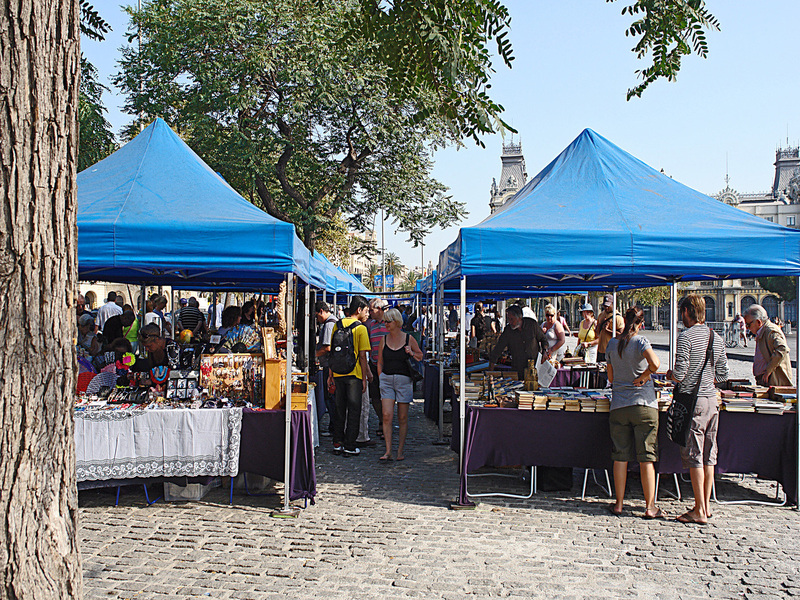
You might be the most experienced craftsperson ever, but let’s face it: we’re all human. As such, we craftspeople are fully capable of making the most stupid mistakes around. These are never more apparent than at craft shows. Here are six simple ways to be prepared for your own slipups:
1. Make a list One way to minimize the potential for making mistakes is to make lists—incredibly detailed lists. It might seem unnecessary to list even the most obvious of things, but as the following example illustrates, everyone has their “moments.”
This actually happened: My husband and I, early in our crafting career, arrived at a weekend Renaissance fair and began setting up our booth. It was a rare local event for us, no more than half an hour from our home. We set up our booth the day before the event, chatting pleasantly with the neighboring vendor on one side who was also setting up. Late in the afternoon, the other neighboring vendor drove up, tired and stressed from a chaotic day of packing his vehicle and driving for four hours.
We greeted each other, made sympathetic noises about his day (haven’t we all had them?), and I’ll never forget what happened next. He opened the back hatch of his truck camper and gave a cry of dismay.
He had forgotten his booth.
It seems he had a nicely decorated pop-up pavilion that he had modified beautifully in order to attend this Renaissance fair. But in the bedlam preceding his departure, the pop-up was left behind. It is seldom that you see a grown man fighting back tears.
With no other options, he got back in his vehicle and drove away. The next morning he was back, with dark circles under his eyes, setting up in the last few hours before the fair opened.
This man was an experienced craftsperson, yet he still made a horrible mistake—thus underscoring the importance of listing everything, big and small, you want to remember when exhibiting at a show.
Sometimes it’s not the big things but the little things that can make or break you…or at least make your vending experience a whole lot less fun than it otherwise might be. And that’s why it’s so important to start that list several weeks in advance…and to write down everything you think you’ll need.
Once upon a time, I went on a writer’s retreat. It was something I’d been looking forward to for a long time. I thought carefully about the items I wanted to bring. I made sure I had my laptop, some nice clothes and all the accoutrements writers need when they get together to collaborate for the weekend.
But it wasn’t until late in the evening of that first day that I realized I’d left behind one absolutely critical piece of equipment: my eyeglasses.
I wear contact lenses through the day but glasses in the evening and at night, and suddenly I had to go blind until morning (I have terrible vision when uncorrected). It was weird and disconcerting to try and be social with my fellow writers (not to mention trying to act professional) when I couldn’t clearly see a hand’s length beyond my face.
But it taught me a lesson. Now, when I’m preparing to be away from home for a conference, craft show or other event, I make a list of everything—every little thing—I know I’ll need during the course of the event… right down to my eyeglasses.
And that becomes the power of the list in preparing. Start that list far in advance (a couple of weeks is ideal) and add to it as you think about the things you want to make sure you don’t forget. The things you think you can’t possibly forget (like glasses! and your booth!) should be first on that list. List even the big things because, well, you never know what kind of mental lapse you’ll have in those last frantic hours as you pack your vehicle and prepare to depart.
2. Have a dress rehearsal I strongly recommend doing a dress rehearsal before going to your show, especially if it’s been a while since the last time. Set up your booth. Set up your shelving or display units. Put all of your stock on the shelves. Put up your signage. If necessary, put on your costume (for themed events like Renaissance fairs). Pretend to process a transaction. There is no finer way to figure out what you’re forgetting.
For example, once a year I do an enormous four-day festival in a huge city two states away. It’s a ten-hour drive to get there, so it’s not like I can dash home if I forget something. I’m good at making lists, so I usually don’t forget anything important.
But one year I forgot to do a dress rehearsal, and boy can something like that throw you for a loop.
What happened was I had a new sign, a large 10-feet-by-4-feet banner that was supposed to attach to a PVC frame and be hoisted above the booth. This way the sign could be seen above the heads of the crowd for a wonderful bit of exposure for our product.
Except for one thing: The PVC rods we bought to frame the sign didn’t fit through the vinyl sleeves of the banner.
So there I was, a country girl in the big city, with no idea where I could find a hardware store to purchase the right PVC poles to complete the structure.
My saving grace was I had arrived a day early. After hastily consulting a phone book and then scouring my city map, I fought rush-hour traffic until I found a hardware store, purchased the PVC pipe and thus saved our signage. But the experience left me frazzled and exhausted, and more appreciative of the need for a dress rehearsal before doing a show.
3. Anticipate the environment It’s impossible to determine everything you may need at a show or event, particularly with outdoor events. But it helps to be aware of the area and/or season.
My husband does a show every September held in the midst of a large mown hayfield. Through harsh experience, he’s learned to bring two critical items: allergy medicine and wasp spray. Both are self-explanatory but neither are items most craftspeople would think to include on their lists of what to bring. This is why advanced knowledge of where a show is being held is so useful. My husband’s allergies are likely to kick up in a hayfield, and everyone knows how much yellow jackets love to nest in holes in the ground, invariably right where you’re assigned to set up your booth.
What about things like sunscreen? A hat? Tissue or handkerchiefs? A small cooler for cold drinks or sandwiches? When you’re doing an outdoor event you’re essentially camping for two days, so prepare accordingly.
Indoor events can be just as important to anticipate. One year we did a reasonably local event held in a college auditorium. What could possibly go wrong?
Well, nothing was wrong per se, but after setting up I realized our booth didn’t have the warm, welcoming atmosphere it normally did. It took a few minutes to understand why. The harsh lighting, generic flooring and echoing nature of the auditorium made for a cold, unwelcoming ambiance no matter how beautifully arranged our products were.
After a hasty trip home for some props, we set out an area rug (to provide a friendly atmosphere as well as muffle the sounds), a floor lamp (for warmer lighting) and brightly colored sheets to drape behind our shelving units to provide a warmer, cozier feel. Not incidentally, it also made our vending experience more comfortable.
4. Preplan ad nauseam The old Boy Scout motto of “Be prepared” applies to everyone, especially if you are a craftsperson who finds yourself far away from home for a vending event.
Did you remember to book a room in advance or make arrangements to stay with friends? One time we drove to a large city for an event and naïvely assumed it wouldn’t be a problem to get a room near the function. Country hicks that we are, it never dawned on us that there might be some monkey wrenches in this obvious plan.
You guessed it, dusk found us driving in an ever-widening circle around the event location, desperately searching for a “vacancy” sign and finding nothing. We finally parked on the street near the function and slept (badly) in the car. It wasn’t until the next day that we found a room many miles from the site (I manned the booth alone for a few hours while my husband searched for a motel). This was in the days before cell phones and it underscored—duh—the need to be prepared to the best of our abilities before leaving home.
The following year, as soon as our application for this same show was accepted, we booked a room in a mid-grade hotel a mere block from the event and have used the same facility ever since.
5. Follow the “rule of three” Sometimes there are things you can’t anticipate or control when doing a craft show. That’s why it’s nice, whenever possible, to have one or two backup options for critical functions (like financial transactions). A prepared neighbor calls this “the rule of three.”
An example of this occurred when my husband exhibited at a large outdoor event in central Oregon. Thankfully, he applied the rule of three when it came to running financial transactions (the whole reason for doing a show, after all).
There was a glitch in the show production and the electricity to his booth was not available. That meant his bank-issued credit card machine, which recorded information and batched files, wouldn’t work.
So my husband fell back on option two, calling in individual credit cards to the bank using his cell phone. That’s when he learned cell phone service wasn’t available at that location. So he fell back on option three, manually running credit cards using a “chunk chunk” machine. That worked perfectly.
As my husband is fond of pointing out, modern electronic devices are great conveniences until they don’t work. As it turned out, his forethought to bring the “chunk chunk” machine and a stack of old-fashioned credit card slips saved the day for us financially.
6. Use a calendar Despite all of our lessons learned, by far the most embarrassing—and costly and stupid—mistake we ever made was to forget the date of a show. Seriously!
No kidding—this is a true story. We had applied to a huge wholesale trade show, were juried in and accepted, paid our $1,000 booth fee and then forgot to write the early-January show date on our calendar. We knew it was in the first month of the year, but what with the holidays and coping with winter snows and dealing with livestock (we live on a farm), we just sort of, well, forgot. Vaguely in the back of our minds we knew we had better start building stock and getting ready, but somehow kept putting it off.
On a Wednesday after Christmas, my husband turned to me and said, “Just when is this show, anyway?”
I located the paperwork, saw the date and my jaw dropped in horror. The show was that weekend. In order to travel to it, I would have to leave the next day.
Needless to say, we weren’t ready. Not even remotely. We had no stock, no order forms, nothing in place that we could throw into the car and make a dash for it.
Swallowing our pride, I confess I called the show producers and lied. I said we were snowed in and would be unable to make the event. It was a year of rough weather, so our story was perfectly believable (in fact, the producer said quite a number of vendors had canceled because of regional flooding), but we had to forfeit our $1,000 booth fee and say good-bye to any potential business the show might have brought us.
Remember, we’re only human This humiliating experience illustrates that, no matter how experienced a craftsperson you might be, things can go spectacularly wrong due to a lack of preparation. Do yourself a favor and be a Boy Scout in your crafting efforts. Be prepared.
Patrice Lewis is a wife, mother, homesteader, homeschooler, author, blogger, columnist, and speaker. An advocate of simple living and self-sufficiency, she has practiced and written about self-reliance and preparedness for almost 30 years. She is experienced in homestead animal husbandry and small-scale dairy production, food preservation and canning, country relocation, home-based businesses, homeschooling, personal money management, and food self-sufficiency. She and her husband have been married since 1990 and have two daughters.






